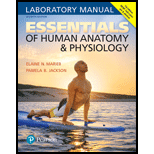
More than one choice may apply.
Microscopic examination of a section of the kidney shows a thick-walled vessel with glomeruli scattered in the tissue on one side of the vessel but not on the other side. What vessel in this?
a. Segmental vein
b. Cortical radiate artery
c. Interlobar vein
d. Arcuate artery
Introduction:
The glomeruli are a bunch of capillaries that help in urine formation. They are scattered in the tissue on one side of the arteries only.
Answer to Problem 1MC
Correct answer:
The thick-walled vessel having glomeruli is scattered on one side of the arcuate artery.
Explanation of Solution
Explanation for the correct answer:
Option (d) is given that arcuate artery is the vessel. The arcuate arteries are the vessels of the kidney that work in the renal circulation. They arc over the medulla of the kidney and, thus, the glomeruli scattered in the tissue are found in one side of the arcuate arteries. Hence, option (d) is correct.
Explanation for incorrect answers:
Option (a) is given that segmental vein is the vessel. However, the segmental vein is not in the kidney. So, it is an incorrect option.
Option (b) is given that cortical radiate artery is the vessel. These are the blood vessels that radiate at the right angle toward the cortical substance from the sides of the arcuate arteries. So, it is an incorrect option.
Option (c) is given that interlobar vein is the vessel. The interlobar vein empties the blood from the kidneys into the inferior vena cava via renal veins. They do not have glomeruli scattered at one side. So, it is an incorrect option.
Hence, options (a), (b), and (c) are incorrect.
The glomeruli are found on one side of the arcuate arteries in the section of the kidney.
Want to see more full solutions like this?
Chapter 15 Solutions
Essentials of Human Anatomy & Physiology Laboratory Manual (7th Edition)
- 12. Calculate the area of a circle which has a radius of 1200 μm. Give your answer in mm² in scientific notation with the correct number of significant figures.arrow_forwardDescribe the image quality of the B.megaterium at 1000X before adding oil? What does adding oil do to the quality of the image?arrow_forwardWhich of the follwowing cells from this lab do you expect to have a nucleus and why or why not? Ceratium, Bacillus megaterium and Cheek epithelial cells?arrow_forward
- 14. If you determine there to be debris on your ocular lens, explain what is the best way to clean it off without damaging the lens?arrow_forward11. Write a simple formula for converting mm to μm when the number of mm's is known. Use the variable X to represent the number of mm's in your formula.arrow_forward13. When a smear containing cells is dried, the cells shrink due to the loss of water. What technique could you use to visualize and measure living cells without heat-fixing them? Hint: you did this technique in part I.arrow_forward
- 10. Write a simple formula for converting μm to mm when the number of μm's are known. Use the variable X to represent the number of um's in your formula.arrow_forward8. How many μm² is in one cm²; express the result in scientific notation. Show your calculations. 1 cm = 10 mm; 1 mm = 1000 μmarrow_forwardFind the dental formula and enter it in the following format: I3/3 C1/1 P4/4 M2/3 = 42 (this is not the correct number, just the correct format) Please be aware: the upper jaw is intact (all teeth are present). The bottom jaw/mandible is not intact. The front teeth should include 6 total rectangular teeth (3 on each side) and 2 total large triangular teeth (1 on each side).arrow_forward
- Answer iarrow_forwardAnswerarrow_forwardcalculate the questions showing the solution including variables,unit and equations all the questiosn below using the data a) B1, b) B2, c) hybrid rate constant (1) d) hybrid rate constant (2) e) t1/2,dist f) t1/2,elim g) k10 h) k12 i) k21 j) initial concentration (C0) k) central compartment volume (V1) l) steady-state volume (Vss) m) clearance (CL) AUC (0→10 min) using trapezoidal rule n) AUC (20→30 min) using trapezoidal rule o) AUCtail (AUC360→∞) p) total AUC (using short cut method) q) volume from AUC (VAUC)arrow_forward
 Medical Terminology for Health Professions, Spira...Health & NutritionISBN:9781305634350Author:Ann Ehrlich, Carol L. Schroeder, Laura Ehrlich, Katrina A. SchroederPublisher:Cengage Learning
Medical Terminology for Health Professions, Spira...Health & NutritionISBN:9781305634350Author:Ann Ehrlich, Carol L. Schroeder, Laura Ehrlich, Katrina A. SchroederPublisher:Cengage Learning Comprehensive Medical Assisting: Administrative a...NursingISBN:9781305964792Author:Wilburta Q. Lindh, Carol D. Tamparo, Barbara M. Dahl, Julie Morris, Cindy CorreaPublisher:Cengage Learning
Comprehensive Medical Assisting: Administrative a...NursingISBN:9781305964792Author:Wilburta Q. Lindh, Carol D. Tamparo, Barbara M. Dahl, Julie Morris, Cindy CorreaPublisher:Cengage Learning





